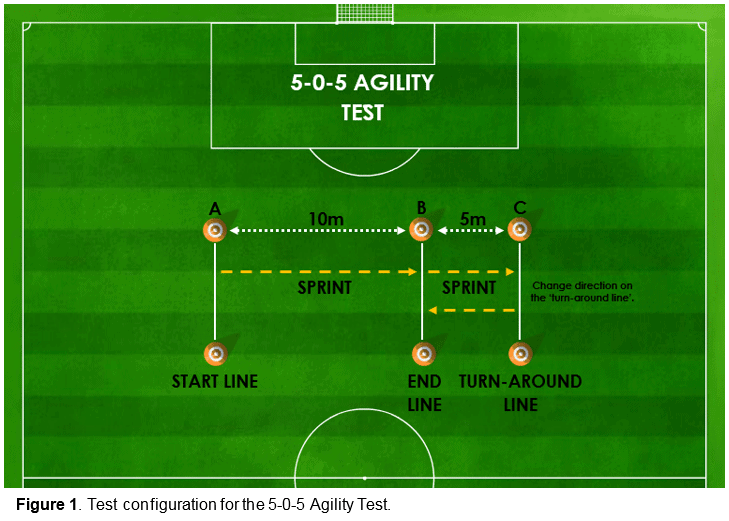Contents of Article
- Summary
- What is the 5-0-5 Agility Test?
- Who should use the 5-0-5 Agility Test?
- How do you conduct the 5-0-5 Agility Test?
- What is the 5-0-5 Agility Test scoring system?
- What considerations are there for the 5-0-5 Agility Test scoring system?
- Is the 5-0-5 Agility Test valid and reliable?
- References
- About the Author
Summary
The 5-0-5 Agility Test is one of the most commonly recognised agility tests, despite its inability to actually measure agility. Instead, this is a change of direction speed (CODs) test, which contrary to common belief, may not be capable of distinguishing between dominant and non-dominant leg performances. Furthermore, there is growing concern regarding its validity to even measure the change of direction speed, primarily due to the length of the sprint distances.
What is the 5-0-5 Agility Test?
Originally developed in 1985, the 5-0-5 Agility Test was created to measure agility in the horizontal plane (1). Interestingly, this test is thought to boost one particular trait that no other CODs test currently withholds. That being, the 5-0-5 agility Test can distinguish between left and right leg performance differences (i.e. dominant vs. non-dominant leg), as it only uses one single 180 degrees change of direction. Most other tests, for example, the Illinois, T-test, Arrowhead, and 5-10-5, all alternate between left and right leg changes of direction during the same performance – masking any differences between each leg’s ability to rapidly change from one direction to another.
Though it is commonly thought the 5-0-5 agility test can distinguish between dominant and non-dominant leg performances, this is yet to be validated by published research. In fact, one unpublished investigation reported no significant difference between dominant and non-dominant leg performances – suggesting there may be no truth in this theory (2). Regardless, the 5-0-5 Agility Test is extremely common in performance testing batteries due to its simplicity and cost-effectiveness.
As the 5-0-5 agility Test is pre-planned and requires no reactive ability, this test is actually a measure of CODs and not agility. Given this, perhaps the name ‘5-0-5 CODs test’ would be less misleading and more appropriate.
Click here for more information regarding the difference between agility and CODs.
Who should use the 5-0-5 Agility Test?
As the ability to change direction rapidly is a vital determinant in many sports, maximising an athlete’s CODs may improve their chances of success (3). Consequently, the 5-0-5 Agility Test may be a useful tool to measure the CODs of any athlete who participates in a sport that contains similar movement patterns.
Furthermore, as the test is typically believed to distinguish between dominant and non-dominant legs, then perhaps this test would be a preferable choice when including a CODs test within the testing battery.
How do you conduct the 5-0-5 Agility Test?
It is important to understand that whenever fitness testing is performed, it must be done so in a consistent environment (e.g. facility) so it is protected from varying weather types, and with a dependable surface that is not affected by wet or slippery conditions. If the environment is not consistent, the reliability of repeated tests at later dates can be substantially hindered and result in worthless data.
Required Equipment
Before the start of the test, it is important to ensure you have the following items:
- Reliable and consistent testing facility of at least 20m in length (e.g. indoor hall or artificial sports field).
- Test administrators (minimum of two).
- Timing gates (preferred, but not essential)
- Measuring tape (≥ 15m)
- Stopwatch
- Marker cones
- Performance recording sheet
Test Configuration
Figure 1 displays the test configuration for the 5-0-5 Agility test. This setup must be adhered to if accurate and reliable data is desired.

Important information for using timing gates
The height of the timing gates has also been proven to significantly affect the performance results (4). When testing, it is therefore imperative that a standardised, consistent protocol is used to reduce variances within the data. For example, it may be suggested that the gates are always set at a consistent height of 1m.
Testing Procedure
Warm-up
- Participants should thoroughly warm up prior to the commencement of the test. Warm-ups should correspond to the biomechanical and physiological nature of the test. In addition, sufficient recovery (e.g. 3-5 minutes) should be administered following the warm-up and prior to the commencement of the test.
Starting the test
- Participant readies themselves on the start-line (cones A – Figure 1) in a standing split start position. It is important for reliability the participant always uses the same starting stance.
- Participant should be counted down ‘3 – 2 – 1 – GO ‘.
- If the test administrators are using a stopwatch, then the timekeeper must stand at the finish line and perform the countdown and time the sprint. The other test administrator must be positioned on the turnaround line to officiate the performance and ensure the athlete’s foot touches the line.
- On the ‘GO’ signal the participant must accelerate maximally to the 15m line (cones C – Figure 1), turn on their RIGHT leg, and sprint back 5m through the finish line (cones B – Figure 1) as quickly as possible. During the turn, the participant MUST NOT touch their inside hand down on the floor.
- Repeat this again, but this time perform a LEFT leg turn and continue to alternate.
- The athlete MUST touch the ‘turnaround line’ on each effort, failing to place their foot on, or across this line, results in a failed attempt. It is encouraged the athletes place their foot on, rather than past the line on each effort to retain test consistency.
- Each participant MUST complete a MINIMUM OF THREE EFFORTS, each separated by a 2-3 minute rest if reliable results are desired.
After the test
- Once the test is over, some subjects may react to the previous exertion. To reduce any problems, the subjects should rest, either sitting or standing, for at least 2-3 minutes. If the subject feels ill or goes quiet or pale, they should lie down with their feet resting on a chair. Note: never leave the participant alone after the test.
In addition to watching the video, it is important you read the test procedure detailed in the toggle box above.
What is the 5-0-5 Agility Test scoring system?
With a minimum of three efforts completed on each leg, the scores are then generated into two mean scores – these provide an overall 5-0-5 agility score for each direction change. This is done by using the following equation.
- Mean score (seconds) = (#1 effort + #2 effort + #3 effort) ÷ total number of effort (e.g. 3)
What considerations are there for the 5-0-5 Agility Test scoring system?
When conducting the test there are several factors that need to be taken into consideration before you begin – some being:
- Accuracy of the stopwatch – Though hand-held stopwatches have been proven to be reliable when measuring speed, they are not recommended when high degrees of precision are required (5, 6). If timing gates are not available, then it is imperative that the test administrators understand the inconsistencies of using a stopwatch for their results. As a result, test administrators must pay great attention and attempt to communicate clearly in order to maximise the accuracy of the results.
- Starting stance – As the starting position can impact performance (7), it is suggested participants always adopt the same starting position. The split stance (one leg forward, and one back) is most recommended.
- Height of the timing gates – To the author’s knowledge, only one study to date has assessed the effects of timing gate height on sprint performance (4). The authors measured significant sprint time differences when the gates were set at 60cm and 80cm. However, there is no current research that identifies an optimal height for testing. As a result, it is highly recommended test administrators adopt one height (e.g. 1m) and stick to it.
- Circadian rhythms – circadian rhythms have been shown to significantly alter anaerobic performance tests. Current knowledge suggests that early morning anaerobic tests will elicit significantly lower peak power values than late afternoon or evening tests (8).
- Surface and conditions – Before conducting the test, ensure the surface is non-slip and consistent (e.g. not affected by weather). Secondly, ensure the environment/facility is also consistent and not affected by weather conditions.
- Individual effort – Sub-maximal efforts can result in inaccurate and meaningless scores.
Is the 5-0-5 Agility Test valid and reliable?
To the author’s knowledge, two studies to date (28/01/16) have measured the validity and reliability of the 5-0-5 Agility Test (2, 9), with only one actually being published (9). Whilst one study suggests the 5-0-5 Agility Test is both valid and reliable (9), the other only supports its reliability (2). Sayers and Killip (2010) suggest the test lacks validity for two primary reasons: 1) it is actually more a measure of CODs and not true agility (previously discussed), and 2) the 5m sprint distance should be reduced to 1m to minimise the influence of linear running ability.
More recent research has also suggested that 5m linear running ability can have too much of an influence on the performance – reducing the isolation on the CODs (10). Despite the concern surrounding its validity, this test has been demonstrated to have sufficient reliability and can, therefore, be performed repeatedly with confidence (2, 9).
- Draper, J and Lancaster, M. The 505 test: A test for agility in the horizontal plane. Aust J Sci Med Sport 17: 15–18, 1985. [Link]
- Sayers, M.G.L., Killip, J.V. (Unknown). Reliability and validity of the 5-0-5 agility test. [Link]
- Sheppard, JM and Young, WB. Agility literature review: Classifications, training and testing. J Sports Sci 24: 919–932, 2006. [PubMed]
- Cronin, J.B., & Templeton, R.L. (2008). Timing light height affects sprint times. Journal of Strength and Conditioning Research, 22(1), 318-320. [PubMed]
- Hetzler, RK, Stickley, CD, Lundquist, KM, and Kimura, IF. Reliability and accuracy of handheld stopwatches compared with electronic timing in measuring sprint performance. J Strength Cond Res 22(6): 1969–1976, 2008 [PubMed]
- Mayhew, JL, Houser, JJ, Briney, BB, Williams, TB, Piper, FC, and Brechue, WF. Comparison between hand and electronic timing of 40-yd dash performance in college football players. J Strength Cond Res 24(2): 447–451, 2010 [PubMed]
- Cronin, J.B., J.P. Green, G.T, Levin, M.E. Brughelli, and D.M. Frost. Effect of starting stance on initial spring performance. Strength Cond. Res. 21(3):990–992. 2007. [PubMed]
- Teo, W., Newton, M.J., & McGuigan, M.R. (2011). Circadian rhythms in exercise performance: Implications for hormonal and muscular adaptation. Journal of Sports Science and Medicine, 10, 600-606. [PubMed]
- Stewart, A.F., Turner, A.N., & Miller, S.C. (2014). Reliability, factorial validity, and interrelationships of five commonly used change of direction speed tests. Scandinavian Journal of Science and Medicine in Sports. 24, 500-506. [PubMed]
- Sayers, MGL. Influence of test distance on change of direction speed test results. J Strength Cond Res 29(9): 2412–2416, 2015 [PubMed]




